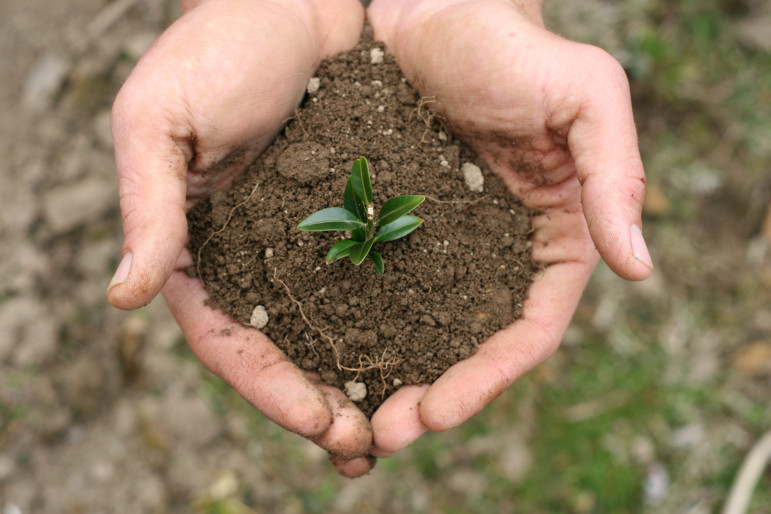[ English | Español ]
Author: Larry Kopald
By looking down, things are looking up.
Here’s a little known fact about climate change: According to NOAA, if we could magically cut all current CO2 emissions worldwide to zero today (a feat even Merlin couldn’t achieve) it would do nothing to stop climate change from continuing to get worse for centuries. Unless we actually draw some of the carbon already emitted back down to earth we are simply telling a 400-pound patient to gain weight a little more slowly.
Amazingly, however, doing so may be significantly easier than reducing emissions. According to a steadily increasing number of studies, it turns out we can blow by the goal of slowing climate change and actually reverse it. While we’ve all been looking to the atmosphere and the amounts of CO2 we emit into it for the answer, the solution itself may be right under our feet. In the dirt.
According to the latest research from Ohio State University’s Rattan Lal, Texas A&M’s Richard Teague, IFOAM’s Andre Leu (as reported in the UN paper “Wake Up Before It’s Too Late” (UN) and the Rodale Institute anywhere from one-third to one-half of manmade CO2 in the atmosphere comes from industrial agriculture. That’s more than all the emissions from the burning of fossil fuels worldwide. How is it possible that with the entire planet focusing on reducing CO2 emissions we’re not even paying lip service to the single largest contributor? (Rodale)
But that’s only half of the story. To makes matters worse, industrial agriculture compounds the problem by preventing soil from reabsorbing that carbon, thus trapping it in the atmosphere.
To understand how, it’s important to remember a few simple facts: There is no waste in nature (she reuses everything); We don’t create carbon (we just move it from place to place); and, nature is literally dying to take back the excess carbon we put into the atmosphere and reuse it to grow us more stuff.
So why isn’t nature doing this? Turns out that our mistreatment of soil is preventing nature from doing what she does naturally and cycling carbon back from the atmosphere. We are literally disrupting the process of photosynthesis — where plants break CO2 molecules apart, release the oxygen and take the carbon underground — by killing the life that should exist in soil that needs that carbon. We do this by spraying it with chemicals, tilling and killing the latticework of fungi, and growing one plant in a field when nature needs variety the same way we need proteins and fats and fruits and vegetables to remain healthy.
Those same studies report that transforming even a small part of industrial agriculture land to healthier, regenerative methods can lead to sequestering more than 100% of current CO2 emissions in just three years. And everything the soil sequesters that’s above what we’re currently emitting will come from — you guessed it — the excess in the atmosphere. That means we are literally beginning to reverse climate change in just a few years. Re-open the pathways, draw down the carbon. (Drawdown)
But haven’t we been told we’ll all starve to death without industrial agriculture? Absolutely, and by some of the same people who tell us the science is still out on climate change. The science shows quite the opposite. In fact, regenerative farming yields are equal to industrial yields in normal weather, and superior to them in stress times of drought and flooding. So we’re not simply reversing climate change, we are creating more food, and more food security. (IFOAM Report)
Currently we have over 400 PPM of carbon in the atmosphere. We have been told we need to stay below 350 to maintain a livable planet. New data, however, report that every 1% of organic matter added to our farming and grazing soil reduces the PPM by 50. Studies have also shown that we could literally return the atmosphere to pre-Industrial Age conditions in as little as twenty years (Drawdown) — the Chinese government studies say it may be forty, but I’d take that deal happily.
The Industrial Revolution lead to explosions in human development, and Industrial Agriculture has enabled us to feed a population that went from one billion to over seven virtually overnight.
But now we know that an unintended consequence of how we fed those people is climate change. Just like it is with how we’ve produced energy. Fortunately, we also now know that we don’t need to continue to use these destructive techniques to feed and power the same amount of people.
Need more proof? Nature’s done this before. During the Cambrian period, and in other volcanic times, the earth saw levels of 600 to as much as 7,000 PPM. And every time, without humans messing up the process, the carbon was reabsorbed into the soil and created an explosion of plant growth. So think abundance, not starvation.
One final point — this is not a license to continue polluting and letting nature deal with it. It’s a gift of time. Time to transform into a carbon-neutral society while also dealing with climate change.
Nature wants to do this. In fact, nature needs to do this. If we let her the planet, and we humans, can all breathe easier.
For more information visit The Carbon Underground here.



